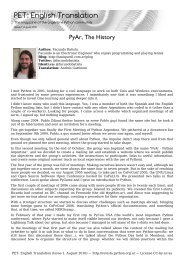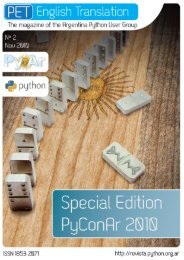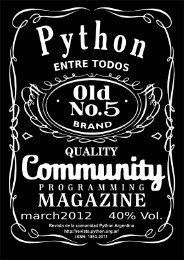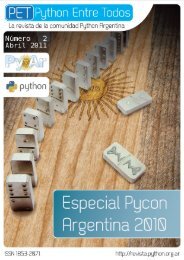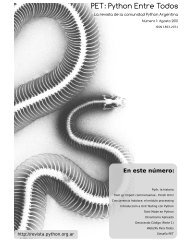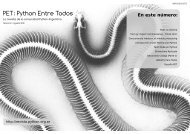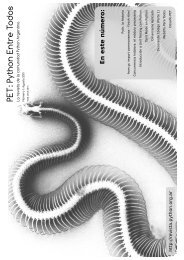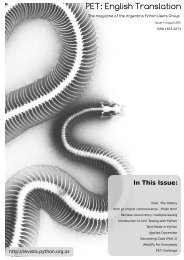color version - PET: Python Entre Todos - Python Argentina
color version - PET: Python Entre Todos - Python Argentina
color version - PET: Python Entre Todos - Python Argentina
Create successful ePaper yourself
Turn your PDF publications into a flip-book with our unique Google optimized e-Paper software.
The Django package includes:<br />
For example, if we want to get all users that are 20 years old, it could be dome through<br />
some code like this:<br />
past_teens = User.objects.filter(age = 20)<br />
[while we are at it: Django’s built-in authentication application already includes a User<br />
class that we can take advantage of :)]<br />
The first tool Django provides is an “Object Relational Mapper” (ORM). The ORM will<br />
allow us to interact with the database so it will be one of the two things that we will<br />
commonly use the most (so pay attention, this is like something that will be in the final<br />
for sure).<br />
Like we are using object-oriented programming, we are going to define and use classes.<br />
Like most commonly used databases are relational databases, Django will take care of<br />
translating our operations on objects into SQL statements that will run on the databases’<br />
tables.<br />
For example: we define our class User with several properties (name, address, email,<br />
etc.). We can then do things like create instances of User, store values in its properties<br />
and tell it: “hey, you, save yourself!”, Django will automagically create the appropriate<br />
update or insert SQL statement and run it in the database.<br />
The code for this example could look like this:<br />
new_user = User()<br />
new_user.name = 'Fisa'<br />
new_user.email = 'fisadev@gmail.com'<br />
new_user.address = 'somewhere in <strong>Argentina</strong>'<br />
new_user.save()<br />
We can now write code that reads from and stores stuff into the database, but that is not<br />
of much use to the user. We have to show him something. The second toll we’re going to<br />
use is the templates system.<br />
What’s that It is what will let us “inject” our data into HTML (or XML, or whatever)<br />
templates that we define.<br />
That is to say that we’ll build the HTML for the user to see in their browser but we’ll say<br />
within the file things like “here goes the name of the current user”.<br />
The template language also provides some basic logic structures that we can use like<br />
loops, conditionals and even some kind of template inheritance.<br />
Just like this, the ORM allows also us to read from the database, filter, run complex<br />
queries, etc.



